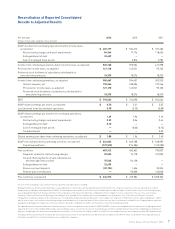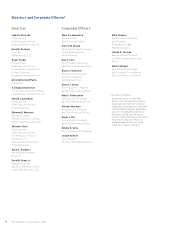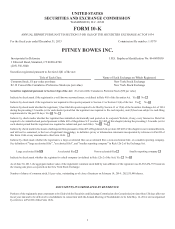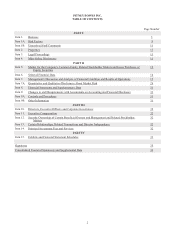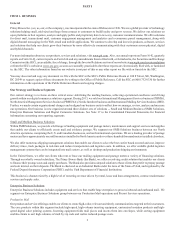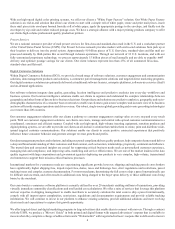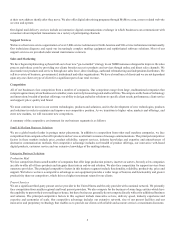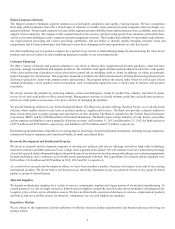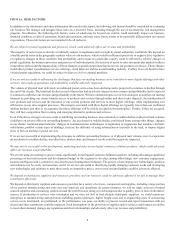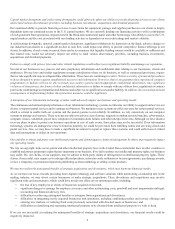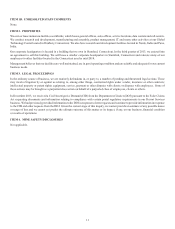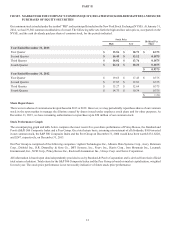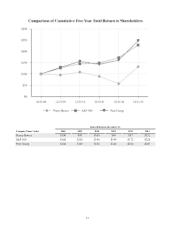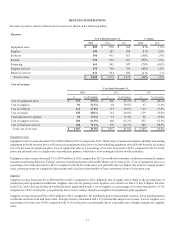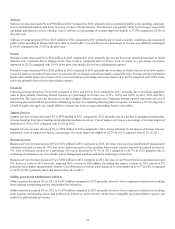Pitney Bowes 2013 Annual Report Download - page 19
Download and view the complete annual report
Please find page 19 of the 2013 Pitney Bowes annual report below. You can navigate through the pages in the report by either clicking on the pages listed below, or by using the keyword search tool below to find specific information within the annual report.8
ITEM 1A. RISK FACTORS
In addition to the disclosures and other information discussed in this report, the following risk factors should be considered in evaluating
our business. We manage and mitigate these risks on a proactive basis, including through the use of an enterprise risk management
program. Nevertheless, the following risk factors, some of which may be beyond our control, could materially impact our business,
financial condition, results of operations, brand and reputation, and may cause future results to be materially different than our current
expectations. These risk factors are not intended to be all inclusive.
We are subject to postal regulations and processes, which could adversely affect our revenue and profitability.
The majority of our revenue is directly or indirectly subject to regulation and oversight by postal authorities worldwide. We depend on
a healthy postal sector in the geographic markets where we do business, which could be influenced positively or negatively by legislative
or regulatory changes in those countries. Our profitability and revenue in a particular country could be affected by adverse changes in
postal regulations, the business processes and practices of individual posts, the decision of a post to enter into particular markets in direct
competition with us and the impact of any of these changes on postal competitors that do not use our products or services. These changes
could affect product specifications, service offerings, client behavior and the overall mailing industry. Further, if we are found to have
violated postal regulations, we could be subject to fines or civil or criminal penalties.
If we are not successful at addressing the challenges that face our mailing business as we transition to more digital offerings and other
services, our results of operations and profitability could be adversely impacted.
The volume of physical mail delivered via traditional postal services has been declining and is projected to continue to decline through
the end of the decade. The historical decline in mail volumes has had an adverse impact on our revenues and profitability and is expected
to continue to influence our revenue and profitability in the future. We have embarked upon a set of new strategies to stabilize our mailing
business by providing our clients broader access to products and services through online and direct sales channels, the introduction of
new products and services and the transition of our current products and services to more digital offerings, while implementing cost
efficiencies in our sales support processes. The margins associated with these digital offerings are typically lower than our traditional
mailing business and there is no guarantee that these offerings will be widely accepted in the marketplace. Further, if they are accepted,
they will face competition from existing and emerging alternative products and services.
Even if the above strategies are successful at stabilizing our mailing business, an accelerated or sudden decline in physical mail volumes
could have an adverse effect on our mailing business. An accelerated or sudden decline could result from, among other things, changes
in our clients' communication behavior, changes in communications technologies or legislation or regulations that mandate electronic
substitution, prohibit certain types of mailings, increase the difficulty of using information or materials in the mail, or impose higher
taxes or fees on mailing or postal services.
If we are not successful at implementing the strategies to stabilize our mailing business, or if physical mail volumes were to experience
an accelerated or sudden decline, our client base, market share and financial results could be negatively impacted.
We may not be successful in the development, marketing and sales of our digital commerce solutions products, which could adversely
affect our revenues and profitability.
We are executing on a strategy to grow revenue significantly in our Digital Commerce Solutions segment, including allocating a significant
percentage of our total research and development budget to this segment to develop, among other things, new customer engagement,
location intelligence and e-commerce cross-border parcel management solutions. The process of developing new technologies, products
and solutions can be costly and uncertain, and if we are not successful at identifying rapidly changing customer needs and developing
new technologies and solutions to meet these needs at competitive prices, our revenue and profitability could be adversely affected.
We depend on third-party suppliers and outsource providers and our business could be adversely affected if we fail to manage these
constituents effectively.
We depend on third-party suppliers and outsource providers for a variety of services, components and supplies, including a large portion
of our product manufacturing and some non-core functions and operations. In certain instances, we rely on single sourced or limited
sourced suppliers and outsourcing vendors around the world because doing so is advantageous due to quality, price or lack of alternative
sources. If production or services were interrupted and we were not able to find alternate third-party suppliers, we could experience
disruptions in manufacturing and operations including product shortages, higher freight costs and re-engineering costs. If outsourcing
services were interrupted, not performed, or the performance was poor, our ability to process, record and report transactions with our
clients and other constituents could be impacted. Such interruptions in the provision of supplies and/or services could impact our ability
to meet client demand, damage our reputation and client relationships and adversely affect our revenue and profitability.


